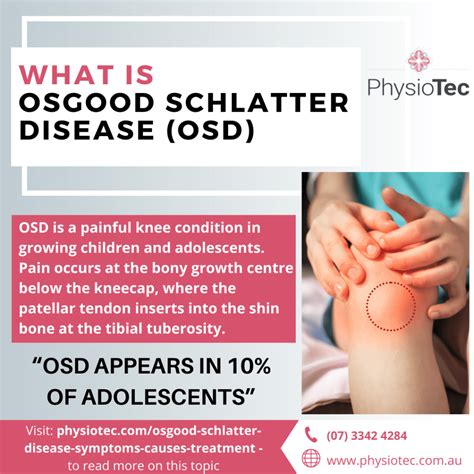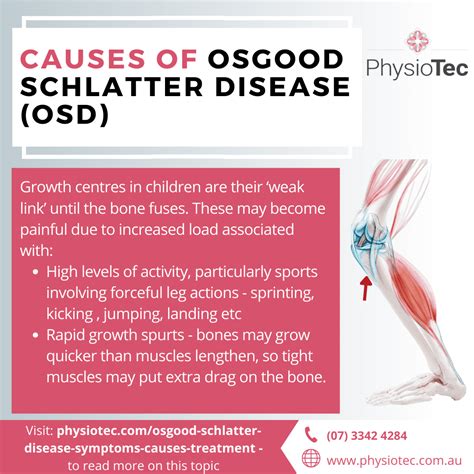Intro
Learn about Osgood Schlatters Disease symptoms, including knee pain, swelling, and lump formation, and discover treatment options for this common growth-related condition affecting adolescents, characterized by inflammation and tendon strain.
Osgood Schlatter disease is a common condition that affects the knees of adolescents, particularly during periods of rapid growth. It is characterized by inflammation of the patellar tendon and the tibial tubercle, which is the bony bump at the top of the shinbone. This condition can cause significant pain and discomfort, making it essential to recognize its symptoms and seek proper treatment.
The symptoms of Osgood Schlatter disease can vary from person to person, but they often include aching or throbbing pain below the knee, usually on one side. The pain can be severe enough to interfere with daily activities, such as walking, running, or climbing stairs. In some cases, the pain may be accompanied by swelling, redness, or warmth around the affected area. The symptoms can be exacerbated by activities that involve running, jumping, or quick changes of direction, which can put additional stress on the knee joint.
As the condition progresses, the pain can become more persistent and may be felt even when the individual is at rest. In some cases, a lump or bump may form below the knee, which can be tender to the touch. The symptoms of Osgood Schlatter disease can be similar to those of other knee conditions, such as tendonitis or bursitis, so it is crucial to consult a healthcare professional for an accurate diagnosis.
Osgood Schlatter Disease Causes and Risk Factors

Osgood Schlatter disease is often caused by overuse or repetitive strain on the knee joint, particularly during periods of rapid growth. This can lead to inflammation and irritation of the patellar tendon and the tibial tubercle. The risk factors for developing Osgood Schlatter disease include participating in sports that involve running, jumping, or quick changes of direction, having a family history of the condition, and experiencing rapid growth spurts during adolescence.
Common Activities that Can Trigger Osgood Schlatter Disease
Some common activities that can trigger Osgood Schlatter disease include: * Running * Jumping * Soccer * Basketball * Gymnastics * Volleyball These activities can put additional stress on the knee joint, leading to inflammation and irritation of the patellar tendon and the tibial tubercle.Osgood Schlatter Disease Diagnosis and Treatment

Diagnosing Osgood Schlatter disease typically involves a physical examination and a review of the individual's medical history. The healthcare professional may also order imaging tests, such as X-rays or an MRI, to rule out other potential causes of the symptoms. Treatment for Osgood Schlatter disease usually involves a combination of rest, ice, compression, and elevation (RICE) to reduce pain and inflammation.
Conservative Treatment Options for Osgood Schlatter Disease
Some conservative treatment options for Osgood Schlatter disease include: * Rest and avoidance of activities that aggravate the condition * Ice packs to reduce pain and inflammation * Compression bandages to help reduce swelling * Elevation of the affected leg to reduce swelling * Physical therapy to improve knee strength and flexibility * Pain relief medication, such as acetaminophen or ibuprofenOsgood Schlatter Disease Prevention and Management

Preventing Osgood Schlatter disease involves reducing the risk of overuse and repetitive strain on the knee joint. This can be achieved by:
- Warming up and stretching before exercise
- Gradually increasing the intensity and duration of physical activity
- Avoiding activities that involve repetitive jumping or running
- Strengthening the muscles around the knee joint through physical therapy
- Wearing proper footwear and using orthotics or shoe inserts to reduce stress on the knee joint
Lifestyle Changes to Manage Osgood Schlatter Disease
Some lifestyle changes that can help manage Osgood Schlatter disease include: * Maintaining a healthy weight to reduce stress on the knee joint * Avoiding smoking and excessive alcohol consumption * Getting regular exercise to improve overall health and well-being * Practicing stress-reducing techniques, such as meditation or deep breathing * Getting enough sleep and rest to allow the body to recover from physical activityOsgood Schlatter Disease Complications and Long-Term Effects

If left untreated, Osgood Schlatter disease can lead to complications, such as chronic pain, limited mobility, and increased risk of developing other knee conditions, such as osteoarthritis. In some cases, the condition can also lead to the formation of a permanent bump or lump below the knee, which can be tender to the touch.
Potential Long-Term Effects of Osgood Schlatter Disease
Some potential long-term effects of Osgood Schlatter disease include: * Chronic pain and stiffness in the knee joint * Limited mobility and reduced range of motion * Increased risk of developing other knee conditions, such as osteoarthritis * Formation of a permanent bump or lump below the knee * Reduced athletic performance and participation in physical activityOsgood Schlatter Disease in Adults

While Osgood Schlatter disease is typically associated with adolescents, it can also occur in adults. In adults, the condition is often caused by overuse or repetitive strain on the knee joint, rather than rapid growth. Treatment for Osgood Schlatter disease in adults usually involves a combination of conservative measures, such as rest, ice, compression, and elevation, as well as physical therapy to improve knee strength and flexibility.
Treatment Options for Osgood Schlatter Disease in Adults
Some treatment options for Osgood Schlatter disease in adults include: * Conservative measures, such as rest, ice, compression, and elevation * Physical therapy to improve knee strength and flexibility * Pain relief medication, such as acetaminophen or ibuprofen * Corticosteroid injections to reduce inflammation and pain * Surgery, in severe cases, to remove the inflamed tissue and repair any damaged tendons or ligamentsWhat is the main cause of Osgood Schlatter disease?
+Osgood Schlatter disease is often caused by overuse or repetitive strain on the knee joint, particularly during periods of rapid growth.
How is Osgood Schlatter disease diagnosed?
+Diagnosing Osgood Schlatter disease typically involves a physical examination and a review of the individual's medical history, as well as imaging tests, such as X-rays or an MRI.
What are the treatment options for Osgood Schlatter disease?
+Treatment for Osgood Schlatter disease usually involves a combination of rest, ice, compression, and elevation (RICE) to reduce pain and inflammation, as well as physical therapy to improve knee strength and flexibility.
We hope this article has provided you with a comprehensive understanding of Osgood Schlatter disease, its symptoms, causes, diagnosis, treatment, and prevention. If you have any further questions or concerns, please do not hesitate to comment below or share this article with others who may be experiencing similar symptoms. Remember to always consult a healthcare professional for an accurate diagnosis and treatment plan. By working together, we can help reduce the risk of Osgood Schlatter disease and promote overall health and well-being.
